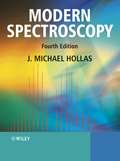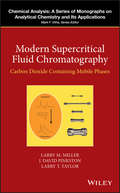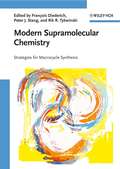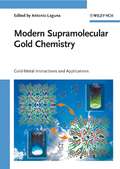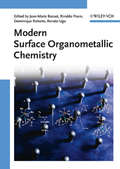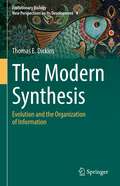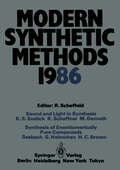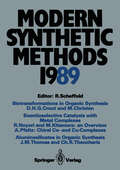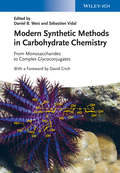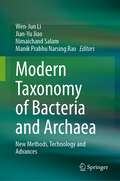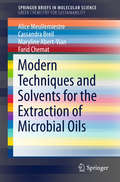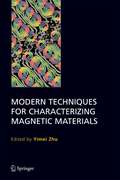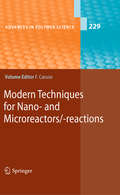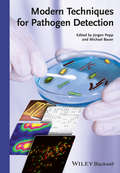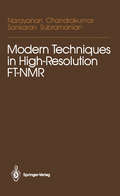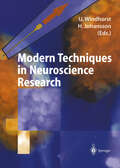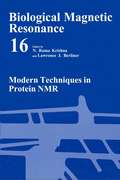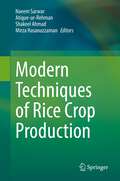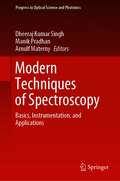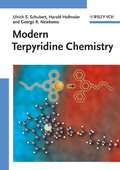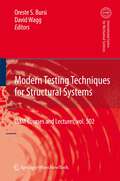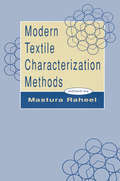- Table View
- List View
Modern Spectroscopy
by J. Michael HollasThe latest edition of this highly acclaimed title introduces the reader to a wide range of spectroscopies, and includes both the background theory and applications to structure determination and chemical analysis. It covers rotational, vibrational, electronic, photoelectron and Auger spectroscopy, as well as EXAFs and the theory of lasers and laser spectroscopy. * A revised and updated edition of a successful, clearly written book * Includes the latest developments in modern laser techniques, such as cavity ring-down spectroscopy and femtosecond lasers * Provides numerous worked examples, calculations and questions at the end of chapters
Modern Supercritical Fluid Chromatography: Carbon Dioxide Containing Mobile Phases (Chemical Analysis: A Series of Monographs on Analytical Chemistry and Its Applications)
by Larry M. Miller J. David Pinkston Larry T. TaylorExplains why modern supercritical fluid chromatography (SFC) is the leading "green" analytical and purification separations technology. Modern supercritical fluid chromatography (SFC) is the leading method used to analyze and purify chiral and achiral chemical compounds, many of which are pharmaceuticals, pharmaceutical candidates, and natural products including cannabis-related compounds. This book covers current SFC instrumentation as it relates to greater robustness, better reproducibility, and increased analytical sensitivity. Modern Supercritical Fluid Chromatography: Carbon Dioxide Containing Mobile Phases covers the history, instrumentation, method development and applications of SFC. The authors provided readers with an overview of analytical and preparative SFC equipment, stationary phases, and mobile phase choices. Topics covered include: Milestones of Supercritical Fluid Chromatography; Physical Properties of Supercritical Fluids; Instrumentation for SFC; Detection in SFC; Achiral SFC Method Development; Chiral SFC Method Development; and Preparative Scale SFC. The book also includes highlights of modern applications of SFC in the final chapters—namely pharmaceuticals, consumer products, foods, polymers, petroleum-related mixtures, and cannabis—and discusses the future of SFC. Provides a clear explanation of the physical and chemical properties of supercritical fluids, which gives the reader a better understanding of the basis for improved performance in SFC compared to HPLC and GC Describes the advantages of SFC as a green alternative to HPLC and GC for the analysis of both polar, water-soluble, and non-polar analytes Details both achiral and chiral SFC method development, including modifiers, additives, the impact of temperature and pressure, and stationary phase choices Details why SFC is the premier modern preparative chromatographic technique used to purify components of mixtures for subsequent uses, both from performance and economic perspectives Covers numerous detectors, with an emphasis on SFC-MS, SFC-UV, and SFC-ELSD (evaporative light scattering detection) Describes the application of SFC to numerous high-value application areas Modern Supercritical Fluid Chromatography: Carbon Dioxide Containing Mobile Phases will be of great interest to professionals, students, and professors involved in analytical, bioanalytical, separations science, medicinal, petroleum, and environmental chemistries. It will also appeal to pharmaceutical scientists, natural-product scientists, food and consumer-products scientists, chemical engineers, and managers in these areas.
Modern Supercritical Fluid Chromatography: Carbon Dioxide Containing Mobile Phases (Chemical Analysis: A Series of Monographs on Analytical Chemistry and Its Applications)
by Larry M. Miller J. David Pinkston Larry T. TaylorExplains why modern supercritical fluid chromatography (SFC) is the leading "green" analytical and purification separations technology. Modern supercritical fluid chromatography (SFC) is the leading method used to analyze and purify chiral and achiral chemical compounds, many of which are pharmaceuticals, pharmaceutical candidates, and natural products including cannabis-related compounds. This book covers current SFC instrumentation as it relates to greater robustness, better reproducibility, and increased analytical sensitivity. Modern Supercritical Fluid Chromatography: Carbon Dioxide Containing Mobile Phases covers the history, instrumentation, method development and applications of SFC. The authors provided readers with an overview of analytical and preparative SFC equipment, stationary phases, and mobile phase choices. Topics covered include: Milestones of Supercritical Fluid Chromatography; Physical Properties of Supercritical Fluids; Instrumentation for SFC; Detection in SFC; Achiral SFC Method Development; Chiral SFC Method Development; and Preparative Scale SFC. The book also includes highlights of modern applications of SFC in the final chapters—namely pharmaceuticals, consumer products, foods, polymers, petroleum-related mixtures, and cannabis—and discusses the future of SFC. Provides a clear explanation of the physical and chemical properties of supercritical fluids, which gives the reader a better understanding of the basis for improved performance in SFC compared to HPLC and GC Describes the advantages of SFC as a green alternative to HPLC and GC for the analysis of both polar, water-soluble, and non-polar analytes Details both achiral and chiral SFC method development, including modifiers, additives, the impact of temperature and pressure, and stationary phase choices Details why SFC is the premier modern preparative chromatographic technique used to purify components of mixtures for subsequent uses, both from performance and economic perspectives Covers numerous detectors, with an emphasis on SFC-MS, SFC-UV, and SFC-ELSD (evaporative light scattering detection) Describes the application of SFC to numerous high-value application areas Modern Supercritical Fluid Chromatography: Carbon Dioxide Containing Mobile Phases will be of great interest to professionals, students, and professors involved in analytical, bioanalytical, separations science, medicinal, petroleum, and environmental chemistries. It will also appeal to pharmaceutical scientists, natural-product scientists, food and consumer-products scientists, chemical engineers, and managers in these areas.
Modern Supramolecular Chemistry: Strategies for Macrocycle Synthesis
by Peter J. Stang Rik R. Tykwinski François DiederichWritten by internationally acclaimed experts, this handy volume covers all major classes of supramolecular compounds. Chapters include cyclophanes, resorcinarene and calixarene synthesis, supramolecular metallomacrocycles and macrocycle synthesis, rotaxane and catenane synthesis, cucurbiturils and porphyrins, as well as macrocyclic drugs. Each chapter contains experimental procedures allowing fast access to this type of synthetic chemistry.
Modern Supramolecular Gold Chemistry: Gold-Metal Interactions and Applications
by Antonio LagunaFilling a gap in our systematic knowledge of gold, this monograph covers the fundamental aspects, while also considering new applications of gold compounds in catalysis, as nanoparticles, and their potential application as luminescent compounds. Written by an eminent team of authors from academia, the book analyzes the current status of gold chemistry, its special characteristics, oxidation states and main type of complexes, before going on to look at the synthesis of supramolecular aggregates due to the formation of gold-gold, gold-metal interactions or other secondary bonds. Final sections deal with LEDs, solvoluminescent and electroluminescent materials, liquid crystals and catalysis. While of interest to advanced chemistry students, this book is also useful for researchers interested in the chemistry of gold and its applications, as well as those involved in metal-metal interactions, heteronuclear chemistry or in the optical properties of coordination compounds.
Modern Surface Organometallic Chemistry
by Jean-Marie Basset Rinaldo Psaro Dominique Roberto Renato UgoCovering everything from the basics to recent applications, this monograph represents an advanced overview of the field. Edited by internationally acclaimed experts respected throughout the community, the book is clearly divided into sections on fundamental and applied surface organometallic chemistry. Backed by numerous examples from the recent literature, this is a key reference for all chemists.
The Modern Synthesis: Evolution and the Organization of Information (Evolutionary Biology – New Perspectives on Its Development #4)
by Thomas E. DickinsThis book is about evolutionary theory. It deals with aspects of its history to focus upon explanatory structures at work in the various forms of evolutionary theory - as such this is also a work of philosophy. Its focus lies on recent debates about the Modern Synthesis and what might be lacking in that synthesis. These claims have been most clearly made by those calling for an Extended Evolutionary Synthesis. The author argues that the difference between these two positions is the consequence of two things. First, whether evolution is a considered as solely a population level phenomenon or also a theory of form. Second, the use of information concepts. In this book Darwinian evolution is positioned as a general theory of evolution, a theory that gave evolution a technical meaning as the statistical outcome of variation, competition, and inheritance. The Modern Synthesis (MS) within biology, has a particular focus, a particular architecture to its explanations that renders it a special theory of evolution. After providing a history of Darwinian theory and the MS, recent claims and exhortations for an Extended Evolutionary Synthesis (EES) are examined that see the need for the inclusion of non-genetic modes of inheritance and also developmental processes. Much of this argument is based around claims that the MS adopts a particular view of information that has privileged the gene as an instructional unit in the emergence of form. The author analyses the uses of information and claims that neither side of the debate explicitly and formally deals with this concept. A more formal view of information is provided which challenges the EES claims about the role of genes in MS explanations of form whilst being consilient with their own interests in developmental biology. It is concluded that the MS implicitly assumed this formal view of information whilst using information terms in a colloquial manner. In the final chapter the idea that the MS is an informational theory that acts to corral more specific phenomenal accounts, is mooted. As such the book argues for a constrained pluralism within biology, where the MS describes those constraints.
Modern Synthetic Methods 1986: Conference Papers of the International Seminar on Modern Synthetic Methods 1986, Interlaken, April 17th/18th 1986 (Modern Synthetic Methods #4)
by H. C. Brown M. Demuth G. Helmchen K. Schaffner D. Seebach K. S. SuslickModern Synthetic Methods 1989 (Modern Synthetic Methods #5)
by David H.G. Crout Markus Christen Ryoji Noyori Masato Kitamura Andreas Pfaltz John M. Thomas Charis R. TheocharisThis paperback is the conference documentation of the fifth Seminar on MODERN SYNTHETIC METHODS 1989. It is the aim of these triennial Interlaken-Seminars to provide a proper, concine and "ready for use" acceos to important and rapidly developing areas of synthetic organic chemistry. Usefu.l synthetic methods have to combine economic and ecological aspects. The search for such methods is a continuous scientific challenge. It implies a solid knowledge a~d updated information on current prospects in biochemistry, organic as well as inorganic chemiotry. The main themes of the 1989-Seminar are "Biotransformations in Organic Synthesis", "Enantioselective Catalyois with Metal Complexes" and "Aluminosilicates in Organic Synthesis". These topics have been chosen, since they reflect the enormous progress in experience and understanding of catalysis in organic syntheGis. This book if' the compilation of the contributions provided by the lecturers of the Seminar. The reviews are written by leading experts and describe not only the basic concepts, their application in oynthesis but also contain representative experimental procedures. The purpose of this volume is twofold. It should aid participants and students in followi~g the lectures. The main reason, however, is to serve ao an updated guide for chemists interested in catalyois applied to organic synthesis.
Modern Synthetic Methods in Carbohydrate Chemistry: From Monosaccharides to Complex Glycoconjugates
by Daniel B. Werz Sébastien Vidal David CrichThe fields of glycochemistry and glycoscience are rich and varied and where much can be learned from Nature. As Nature is not always able to produce carbohydrates in quantities useful for not only in research but also as therapeutic agents, new ways need to be found to optimize the yield. This book presents an overview of the latest developments in the field of carbohydrates, ranging from de-novo approaches via cyclodextrin chemistry to the synthesis of such highly complex glycoconjugates as glycosphingolipids and GPI anchors. The main emphasis remains on the synthetic aspects making the book an excellent source of information for those already involved in carbohydrate chemistry, as well as for those organic chemists who are beginners in this field. Equally of interest to synthetic chemists, as well as medicinal chemists and biochemists.
Modern Synthetic Methods in Carbohydrate Chemistry: From Monosaccharides to Complex Glycoconjugates
by Daniel B. Werz Sébastien Vidal David CrichThe fields of glycochemistry and glycoscience are rich and varied and where much can be learned from Nature. As Nature is not always able to produce carbohydrates in quantities useful for not only in research but also as therapeutic agents, new ways need to be found to optimize the yield. This book presents an overview of the latest developments in the field of carbohydrates, ranging from de-novo approaches via cyclodextrin chemistry to the synthesis of such highly complex glycoconjugates as glycosphingolipids and GPI anchors. The main emphasis remains on the synthetic aspects making the book an excellent source of information for those already involved in carbohydrate chemistry, as well as for those organic chemists who are beginners in this field. Equally of interest to synthetic chemists, as well as medicinal chemists and biochemists.
Modern Taxonomy of Bacteria and Archaea: New Methods, Technology and Advances
by Wen-Jun Li Jian-Yu Jiao Nimaichand Salam Manik Prabhu Narsing RaoThis book introduces the current approaches in prokaryotic taxonomy and streamlines the advanced techniques for use in prokaryotic systematics. While highlighting the key differences in the taxonomy of cultured and not-yet-cultured bacteria and archaea, it presents the genomic technology involved in microbial systematics that serves as comprehensive guidelines for isolating and identifying bacteria. Microbial systematics is a fundamentally important discipline area for microbiologists and those seeking to understand Earth’s biodiversity. As bacterial taxonomy is critical in microbial ecology and clinical microbiology works, the correct identification of microbes is crucial. However, the microbial collection existing and described as cultured species so far are either based on the taxonomic pattern that existed during its time of first cultivation. With evolving technology, many microbes were found to be wrongly classified. Therefore, it is essential to keep in contact withthe developing technology and methods for the correct placement of cultured bacteria and their identification. This book is an excellent guideline for adequately identifying, classifying, and describing novel taxa of bacteria and archaea.
Modern Techniques and Solvents for the Extraction of Microbial Oils (SpringerBriefs in Molecular Science)
by Alice Meullemiestre Cassandra Breil Maryline Abert-Vian Farid ChematA valuable reference presenting many processes that facilitate lipid extraction from micro-organisms. Amongst the techniques included are Folch, Bligh and Dyer methods, and the Soxhlet technique as well as intensified green processes (ultrasound, microwave, supercritical fluid extraction, agro-solvent, accelerated solvent extraction, enzyme-assisted extraction, instant controlled pressure drop, pulse electric field). In addition to a section featuring the analysis of fatty acids by Gas Chromatography and lipids by High-Performance Thin-Layer Chromatography (HPTLC), this brief contains a valuable bibliography on microorganisms (classes, structures) and their applications as a source of value added oils and compounds for food and non-food applications such as biojet fuel.
Modern Techniques for Characterizing Magnetic Materials
by Yimei ZhuModern Techniques for Characterizing Magnetic Materials provides an extensive overview of novel characterization tools for magnetic materials including neutron, photon and electron scatterings and other microscopy techniques by world-renowned scientists. This interdisciplinary reference describes all available techniques to characterize and to understand magnetic materials, techniques that cover a wide range of length scales and belong to different scientific communities. The diverse contributions enhance cross-discipline communication, while also identifying both the drawbacks and advantages of different techniques, which can result in deriving effective combinations of techniques that are especially fruitful at nanometer scales. It will be a valuable resource for all graduate students, researchers, engineers and scientists who are interested in magnetic materials including their crystal structure, electronic structure, magnetization dynamics and their associated magnetic properties and underlying magnetism.
Modern Techniques for Nano- and Microreactors/-reactions (Advances in Polymer Science #229)
by Frank Caruso-Encapsulation by Miniemulsion Polymerization By K. Landfester and C. K. Weiss -Enzyme-Encapsulated Layer-by-Layer Assemblies: Current Status and Challenges Toward Ultimate Nanodevices By K. Ariga, Q. Ji, and J. P. Hill -Non-LBL Assembly and Encapsulation Uses 1 of Nanoparticle-Shelled Hollow Spheres 2 By G.C. Kini, S. L. Biswal, and M. S. Wong -Polymersomes: A Synthetic Biological Approach to Encapsulation and Delivery By M. Massignani, H. Lomas, and G. Battaglia -Reaction Vessels Assembled by the Sequential Adsorption of Polymers By A.D. Price, A.P.R. Johnston, G.K. Such, and F. Caruso
Modern Techniques for Pathogen Detection
by Jürgen PoppThis outstanding overview sets a new standard for a methods book on pathogen detection. The first chapter provides an outline of currently used routine methods, including their background, strengths and weaknesses, as well as comparing them to newer methods. The following chapters then cover novel methods already in wide use and which are still more experimental for routine purposes. An invaluable resource for all medical laboratories and clinical institutions dealing with infectious diseases.
Modern Techniques for Pathogen Detection
by Jürgen Popp Michael BauerThis outstanding overview sets a new standard for a methods book on pathogen detection. The first chapter provides an outline of currently used routine methods, including their background, strengths and weaknesses, as well as comparing them to newer methods. The following chapters then cover novel methods already in wide use and which are still more experimental for routine purposes. An invaluable resource for all medical laboratories and clinical institutions dealing with infectious diseases.
Modern Techniques in High-Resolution FT-NMR
by Narayanan Chandrakumar Sankaran SubramanianThe magnetism of nuclear spin systems has proved an amazingly fertile ground for the creativity of researchers. This happy circumstance results from the triple benediction that nature appears to have bestowed on nuclear spins: they are sporting spies-being infinitely manipulable (one is even tempted to say malleable), not unduly coy in revealing their secrets, and having a whole treasure house of secrets to reveal in the first place. researcher with Since spin dynamics are now orchestrated by the NMR ever more subtle scores, it is important to be able to tune into the pro ceedings with precision, if one is to make sense of it at all. Fortunately, it is not terribly difficult to do so, since in many ways spin dynamics are the theoretician's dream come true: they are often finite dimensional and quite tractable with basic quantum mechanics, frequently allowing near exact treatments and readily testable predictions. This book was conceived two years ago, with the objective of providing a simple, consistent introduction to the description of the spin dynamics that one encounters in modern NMR experiments. We believed it was a good time to attempt this, since it was possible by then to give sufficiently general descriptions of powelful classes of new NMR experiments. The choice of experiments we discuss in detail is necessarily subjective, al though we hope to have given a flavor of most of the important classes of pulse sequences, including some surface coil imaging applications.
Modern Techniques in Neuroscience Research
by Uwe Windhorst Hakan JohanssonAn overview of the techniques used in modern neuroscience research with the emphasis on showing how different techniques can optimally be combined in the study of problems that arise at some levels of nervous system organization. This is essentially a working tool for the scientist in the laboratory and clinic, providing detailed step-by-step protocols with tips and recommendations. Most chapters and protocols are organized such that they can be used independently, while cross-references between the chapters, a glossary, a list of suppliers and appendices provide further help.
Modern Techniques in Protein NMR (Biological Magnetic Resonance #16)
by N. Rama Krishna Lawrence J. BerlinerVolume 16 marks the beginning of a special topic series devoted to modern techniques in protein NMR, under the Biological Magnetic Resonance series. This volume is being followed by Volume 17 with the subtitle Structure Computation and Dynamics in Protein NMR. Volumes 16 and 17 present some of the recent, significant advances in biomolecular NMR field with emphasis on developments during the last five years. We are honored to have brought together in these volumes some of the world’s foremost experts who have provided broad leadership in advancing this field. Volume 16 contains advances in two broad categories: the first, Large Proteins, Complexes, and Membrane Proteins, and second, Pulse Methods. Volume 17, which will follow covers major advances in Computational Methods, and Structure and Dynamics. In the opening chapter of Volume 16, Marius Clore and Angela Gronenborn give a brief review of NMR strategies including the use of long range restraints in the structure determination of large proteins and protein complexes. In the next two chapters, Lewis Kay and Ron Venters and their collaborators describe state-of-t- art advances in the study of perdeuterated large proteins. They are followed by Stanley Opella and co-workers who present recent developments in the study of membrane proteins. (A related topic dealing with magnetic field induced residual dipolar couplings in proteins will appear in the section on Structure and Dynamics in Volume 17).
Modern Techniques of Rice Crop Production
by Naeem Sarwar Atique-Ur-Rehman Shakeel Ahmad Mirza HasanuzzamanThis book collects all the latest technologies with their implications on the global rice cultivation. It discusses all aspects of rice production and puts together the latest trends and best practices in the rice production. Rice is produced and consumed worldwide and especially an important crop for Asia. It is a staple food in majority of population living is this continent which distinguishes this from rest of the world. Climatic fluctuations, elevated concentrations of carbon dioxide, enhanced temperature have created extreme weather conditions for rice cultivation. Also, increasing pest attacks make situation complicated for the farmers. Therefore, rice production technology also has to be adjusted accordingly. This book is of interest to teachers, researchers, plant biotechnologists, pathologists, agronomists, soil scientists, food technologists from different part of the globe. Also, the book serves as additional reading material for students of agriculture, soil science, and environmental sciences. National and international agricultural scientists, policy makers will also find this to be a useful read
Modern Techniques of Spectroscopy: Basics, Instrumentation, and Applications (Progress in Optical Science and Photonics #13)
by Dheeraj Kumar Singh Manik Pradhan Arnulf MaternyThe book highlights recent developments in the field of spectroscopy by providing the readers with an updated and high-level of overview. The focus of this book is on the introduction to concepts of modern spectroscopic techniques, recent technological innovations in this field, and current examples of applications to molecules and materials relevant for academia and industry. The book will be beneficial to researchers from various branches of science and technology, and is intended to point them to modern techniques, which might be useful for their specific problems. Spectroscopic techniques, that are discussed include, UV-Visible absorption spectroscopy, XPS, Raman spectroscopy, SERS, TERS, CARS, IR absorption spectroscopy, SFG, LIBS, Quantum cascade laser (QCL) spectroscopy, fluorescence spectroscopy, ellipsometry, cavity-enhanced absorption spectroscopy, such as cavity ring-down spectroscopy (CRDS) and evanescent wave-CRDS both in gas and condensed phases, time-resolved spectroscopy etc. Applications introduced in the different chapters demonstrates the usefulness of the spectroscopic techniques for the characterization of fundamental properties of molecules, e.g. in connection with environmental impact, bio-activity, or usefulness for pharmaceutical drugs, and materials important e.g. for nano-science, nuclear chemistry, or bio-applications. The book presents how spectroscopic techniques can help to better understand substances, which have also great impact on questions of social and economic relevance (environment, alternative energy, etc.).
Modern Terpyridine Chemistry
by Ulrich Schubert Harald Hofmeier George R. NewkomeThe first book to didactically illustrate this particular, prominent class of supramolecular building-blocks covers topics ranging from terpyridine syntheses, via their chemistry and properties, supramolecular structures, and multinuclear metal complexes, right up to functionalized polymers, 3D-architectures, and surfaces. Invaluable for students and lecturers in chemistry and biochemistry, materials scientists, as well as polymer, complex and physicochemists.
Modern Testing Techniques for Structural Systems: Dynamics and Control (CISM International Centre for Mechanical Sciences #502)
by Oreste S. Bursi David WaggThe articles in this book describe new developments in the area of structural testing, particularly those based upon the principle of fusing numerical and experimental methods such as real-time dynamic substructuring and hardware-in-the loop testing. In addition to the hybrid methods, chapters on the latest develoments in more established techniques, such as shaking table testing, provide a completely up-to-date survey of structural testing methods. The book is characterized by a multidisciplinary nature of the work that integrates cutting-edge research from the fields of non-linear dynamics, automatic control, numerical analysis, system modelling and mechatronics.
Modern Textile Characterization Methods (International Fiber Science and Technology)
by Mastura RaheelThis work details current advances in assessing the characteristics of polymers, single fibres and fibrous systems, and associated processes based on evolving theories in the physical, chemical and mechanical sciences. It focuses on recent develpments in selected characterization methods - such as Fourier transform infrared spectroscopy, Fourier transform nuclear magnetic resonance, electron diffraction, x-ray diffraction and electron microscopy - applicatble to polymers, fibres and textiles.
